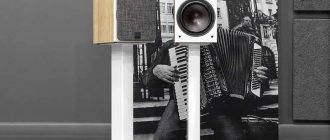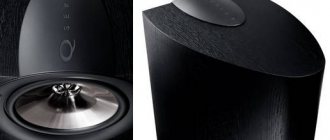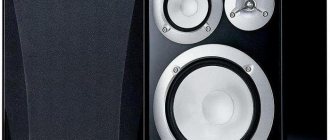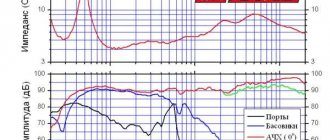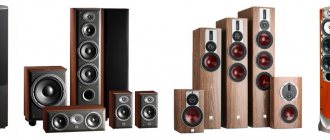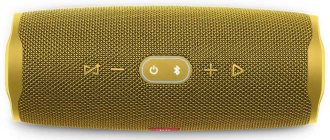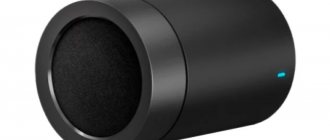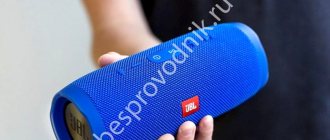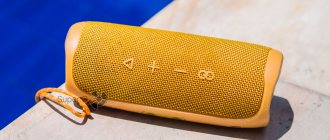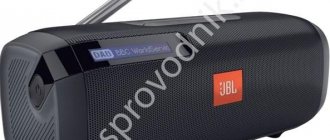Bookshelf speakers DALI Zensor 1 – review Stereophile
For the Danish-designed DALI Zensor system (assembled in China), I decided to reconsider my usual procedure for writing reviews of affordable speakers because of one unexpected twist.
Price 475 USD
Typically, when preparing a review of available speakers, I compile a list of potential candidates that I have either encountered at various audio shows or have been recommended to me directly by other writers on Stereophile. To this list, I add products that I have learned about through advertisements in relevant publications—usually manufacturers whose products have impressed me in the past. From there, I'll shorten this list as best I can and check in with Steven Mayhasom to make sure I'm not reinventing the wheel in my quest for budget audio nirvana. I discuss the result with John Atkinson, who advises me in what order I should do the next three or four reviews in order to captivate readers as much as possible.
Given the amount of time it takes to order and receive a pair to write a review, by the time I'm ready to compare them to similar offerings in their price range, I've already forgotten their exact retail price. I always check with the manufacturer or distributor to make sure prices are up to date and to select similar speakers for comparison - and given the fact that foreign exchange rates fluctuate, it is not unusual for the price to change from the original price by the time I write a review.
After finishing listening to the Zensor 1s, made by Danish Audiophile Loudspeaker Industries (DALI), I took a look at these miniature bookshelf speakers and tried to remember their price. Based on the sound quality compared to other systems, I assumed the price should be in the $1000-$1200 per pair range. When I contacted DALI's American distributor, The Sound Organization, and heard that the retail price was $475 per pair, it shocked me. As with all of my reviews, my comments in the Listening section are made without regard to retail price.
Design
The Zensor series is DALI's attempt to produce entry-level speakers that "meet the highest standards at all price points" - something DALI has strived to do across all of its ranges over the years. The Zensor 1 bookshelf speakers are the smallest of the three Zensor speakers, but they all share the same design philosophy. So, every Zensor product features a smooth linear impedance designed to perfectly match any amplifier. The speaker components have been selected to provide maximum wide-directivity. The Zensor 1's woofer features a 13.3 cm cone made from fine-grain paper and reinforced with wood fibers to achieve a combination of rigidity and lightness. The 25mm high-frequency driver is lightweight and has a high-energy drive to produce small amplitude vibrations at high speeds. The body is made of MDF with a laminated surface. The front panel is finished in glossy black or white lacquer. The speakers are available in light walnut and dark ash; Personally, I found dark ash more sophisticated and attractive. Without the grilles, the sound was a little clearer, and there was a certain sparkle in the upper range, and that’s exactly how I listened to these speakers.
Listening
What immediately struck me was the Zensor 1's ability to capture the delicate, non-dynamic articulation of good jazz recordings. On "One in Four" from The Paul Bley Quartet (CD, ECM 1365), John Surman's soprano saxophone soared above the cymbals and snare drum, all held together by Bley's dynamic piano. In a similar vein, I was captivated by the minimalist acoustic piano arrangement of "Hey Joe" from Medeski Martin & Wood's Tonic (CD, Blue Note 0946356942), where Chris Wood's snare and cymbal sounds came into sharp focus. But what completely blew my mind was the interplay between Dino Saluzzi's bandoneon and his son, José Maria's acoustic guitar, on the album "Dino's Cité de la Musique" (CD, ECM 1616). Leading the album's sound is bassist Mark Johnson, and Saluzzi's dynamically adapting instrumentation breathes organic life into the recordings, with clear forms ranging from pppp (piano - soft) to mf (mezzo forte - moderately loud).
I know very well what the bandoneon and its cousin the accordion should sound like. In 1987, as an opening act at a concert, I performed one of my own works on accordion at Carnegie Hall. And now I'm staring at the Zensor 1 - Saluzzi's bandoneon is on most of the record - and I'm saying to myself, "Wow, there really is a bandoneon in the room."
Women's voices are great for testing the plausibility of timbre in the midrange, and Joni Mitchell's voice in the composition "Urge for Going" from the album "Hits" (CD, Reprise 46326-2) was silky, warm and smooth, with its own rises and pauses, and all this without a hint of unnecessary coloring. DALI's extended, detailed and refined treble was also clearly evident in the Martin guitar harmonics in this track. On the same album, Mitchell's guitar had to play more aggressively on "Big Yellow Taxi" and "Chelsea Morning" and the sound became more percussive and rough.
DALI's ability to clearly reproduce high frequencies is ideal for reproducing wind instruments. Thus, Miles Davis's trumpet on Filles de Kilimanjaro (CD, Columbia EK 86555) was sharp and metallic, with a long, silky echo and atmosphere. John Zorn's chamber piece "Orphée" from the album Mysterium (CD, Tzadik 8018) is not the easiest test for the upper frequencies, but the higher octaves of Tara Helen O'Connor's flute were plangent and atmospheric, with the necessary minimum of metallic hue. The killer interplay between Stephen Gosling's celesta, David Shively's drums and Luke Morey's electric drums was clear, drawn-out and atmospheric, without any blurriness. The explosive drum solo (Arthur Trippe?) in Frank Zappa's "Naval Aviation in Art" from the album "Läther" (CD, Rykodisc RCD 10574/76) was conveyed in all its volume without sacrificing any individual nuances.
Zensor 1 has an excellent sense of rhythm, if we take as an example the interaction of background drums and solo melodic instruments. In "Song IV" from Peter Zammo's "Zummo with an X" (CD, New World 80656-2), Billy Ryle sets a hypnotic, repeating general tabla (small double drum) line in a contrapuntal style that is the basis of long, angular and also the hypnotic sounds of Zammo's trombone. During this 20-minute track, the music completely enveloped me - I found myself rooted to the spot, unable to concentrate on anything else until the song finished playing. On "Blind Man Blind Man" from Herbie Hancock's My Point of View (CD, Blue Note 5 21226 2), bassist Chuck Israel does a very good job of blending sounds with drummer Tony Williams, which came through with amazing clarity through the Zensor 1. On Marc Ribot y Los Cubanos Postizos (CD, Atlantic 83116), where Ribot pays tribute to the music of Arsenio Rodriguez, the Rodriguez brothers' dual percussion created DALI-linked transitions.
The Zensor 1's bass performance is a bit schizophrenic. Some frequencies in the upper part of the bass range were transmitted a little more densely, which for the most part did not affect the transmission of music, but sometimes either added drama to the work or thickened it a little. On "Chairman Mao" from Denny Zeitlin and Charlie Haden's Time Remembers One Time Once (CD, ECM 1239), Haden's solo bass section sounded raspy and woodsy, just like when they performed live in the mid-'70s with Keith Jarrett. , Dewey Redman and Paul Motian.
On certain recordings, the bass output from the DALI gave the illusion of a huge floor-standing speaker. Mark Johnson's double bass on the Shades of Jade album (CD, ECM 1894) sounded, according to my notes, "the most natural sound I have ever heard from speakers of such small size." But the sound of Marc Ribot's electric guitar from his above-mentioned composition was rough at the beginning of the middle and end of the lower ranges, which ultimately affected the sound quality. Maybe Ribot intended it this way, but on other recordings this effect was reproduced again. For example, on guitarist Jim Hall's "Bent Blue" from the album Jim Hall and Basses (CD, Telarc CD-83506), Christian McBride's double bass sounded a little hollow in the middle octaves.
But overall, especially when playing classical songs, the Zensor 1 sound like real BIG speakers. György Ligeti's cello concerto, recorded as an open performance by Siegfried Palm and Reinbert de Leeuw of the Schînberg Ensemble (CD, Teldec 8573-87631-2), had a sense of space, drama and dynamics. I heard every single bagpipe note on Dewar's Bagpipe Festival Live at the Knitting Factory (CD, Knitting Factory Works KFWCD-133). I'm very familiar with bagpipes - my son Jordan, a competitive Irish dance soloist, danced in the St. Patrick's Day Parade in New York City, and my wife and I marched behind him. According to the regulations, we had to line up two hours before the start of the parade, so every year we had the privilege of standing near the area of practicing bagpipes. This instrument sticking out of the mouth sounds like an amplifier passing through the entire throat. DALI captures this effect beautifully in piper George Balderose's Piobaireachd: The Lament for Alisdair Dearg. The sound was so frantic that it was difficult to concentrate on anything else while the music was playing.
Despite the fact that the Zensor 1 are tiny speakers, this pair is capable of creating the sensation of a loud, enveloping orchestral sound. David Chesky's Violin Concerto performed by Tom Chiu and Anthony Abel from Area 31 (SACD/CD, Chesky SACD288; CD layer) conveys a sense of drama and space during the timpani introduction. But it’s difficult for Zensor speakers to go beyond their limits when trying to fill a large room with disco sounds. When listening to Lady Gaga's album “Born This Way” (CD, Streamline/Interscope B001337302) at a volume exceeding 95 dB, the DALI “gave up” and began to slip in the upper mid-range.
Comparison
I compared the DALI Zensor 1 ($475/pair) with the Epos ELS3 ($295/pair), Wharfedale Diamond 10.1 ($350/pair) and Epos M5i ($899/pair).
The Epos ELS3 sound was more closed, especially in the upper part of the sound range, than the DALI, although the timbre was very natural. The highs are less clear than the DALI, but the woofers were just as good. The bass range of the ELS3 is extended, as is that of the Zensor 1, but the upper frequencies in the lower range of the Epos are cleaner. The hissing sounds of the ELS3 are less natural, and the transmission of sound dynamics in the DALI is also a little better.
The Wharfedale Diamond 10.1 has deeper and warmer bass than the DALI or ELS3. Diamond's detail isn't as good as Zensor 1's, but it's much better than ELS3's. The Wharfedale's level of detail also falls somewhere between DALI and ELS3.
The Epos M5i had slightly more responsive, detailed sound with less decay time than the DALI, but the high frequencies were comparable to the Zensor 1. Of all the speakers reviewed here, the M5i has the deepest, most natural bass, as well as the clarity of musical dynamics.
Conclusion
In Zensor 1, DALI have implemented surprisingly realistic speakers for their price and size. With minimal downsides, the Zensor 1's strengths rival those of bookshelf speakers costing twice as much or more. I'm amazed how such tiny speakers can create such spacious sound across different genres of music. This attractive babe sets a new level in her class that will not be easy to conquer. Great job!
Specifications
Type: two-way bookshelf speakers with rear port Drivers: 25mm tweeter with fabric dome, 5.25″ woofer with paper cone. Crossover frequency: 2.9 kHz. Frequency range: 53 Hz–26.5 kHz, ±3 dB. Nominal impedance: 6 ohms. Sensitivity: 86.5 dB Recommended amplifier power: 25–100 W. Dimensions: 274 X 162 X 220 mm Weight: 4.2 kg. Finish: Black, White, Light Walnut (vinyl). Price: $475 per pair. Manufacturer: DALI A/S, Dali Allé 1, DK-9610 Norager, Denmark.
Equipment used
Analogue sources: VPI TNT IV, Rega Planar 3 turntables; Immedia, Syrinx PU-3 tonearms; Koetsu Urushi, Clearaudio Virtuoso Wood cartridges. Digital sources: Lector CDP-7T, Creek Destiny CD players. Preamps: Vendetta Research SCP-2D, Creek Destiny phono stages; Audio Valve Eclipse line stage. Power Amplifier: Audio Research Reference 110. Integrated Amplifier: Creek Destiny. Acoustics: Epos ELS3 & M5i, Wharfedale Diamond 10.1. Cables: Interconnect (all MIT): Magnum M3, MI-350 CVTwin Terminator, MI-330SG Terminator. Speaker: Acarian Systems Black Orpheus.
Based on materials from Stereophile Author Robert J. Reina
admin
See author's posts
Review. Acoustic systems DALI Zensor. Triumph of technology
When we set out to test speaker systems, we are offered only one pair, usually the oldest or the next one. From the point of view of assessing the capabilities of the company and technology, this is probably correct. On the other hand, top-end models are usually expensive, and just because they sound great doesn't always mean that lower-end models are just as good.
This time we were able to test the entire line from the Zensor model range of the Danish company Dali, which is represented by four bookshelf (3, 1, Pico, 1 AX) and three floor-standing (7, 5, 5 AX) speakers. Such a wide range of models within one line allows you to choose speakers to suit the requirements of a specific room and application. From a stereo system for virtually any room size to a home theater system.
Look and feel.
Like all DALI products, the Zensor family looks stylish. Typical Scandinavian design with classic shapes will confidently fit into any modern interior. The cabinets, which have a dull response when tapped with your knuckles, are covered in a textured laminate (available in three finishes: Black Ash, Light Walnut and White). The front panels of the cases are finished in piano lacquer and respond even more muted to tapping. The weight of the speakers corresponds to the size.
The quality of workmanship is impeccable, everything is thought out to the smallest detail! The fastener bears a company marking. Floor-standing models are installed on an elegant aluminum base. The shelf models are supplied with rubber feet; the floor models are supplied with spikes in addition to the rubber feet (fastening - M8 thread). The output terminals are very similar to the WBT products and allow the use of all types of connectors, both bare wire and spade/banana. Bi-wiring and bi-amping connections are not provided. The nominal impedance value of all speakers declared by the manufacturer is 6 Ohms.
Active speakers Zensor 5 AX and 1 AX are equipped with built-in class D amplifiers (both channels and the power supply are located in the left speaker) and allow connection of analog (3.5 mm minijack) and digital (TosLink 16/24 bit, – 32-176.4 kHz; BlueTooth APT-X) sources, and also have an analog RCA output to the subwoofer. The amplifier panels are located on the lower part of the rear wall of the speakers (volume control buttons “+” and “-”, source selection button, power switch, power connector C8. The LED status indicator is located on the front panel of the speakers. Active speakers are equipped with a small but quite convenient full-featured remote control.
Technologies.
All DALI design solutions lead to a methodical and consistent reduction in speaker distortion. For this reason, the speakers are designed by DALI engineers and manufactured in the DALI factory. In the manufacture of low-frequency/mid-frequency diffusers, paper with natural fillers made from wood fibers is used, and silk is used in the construction of high-frequency domes. Lightweight and at the same time rigid diffusers guarantee good macro/microdynamics and high sound transparency. Further reduction of losses is facilitated by the high quality of the crossover element base, and the same crossovers are used in active speakers as in the corresponding passive ones.
All speakers in the Zensor line are made according to a two-way design with crossover frequencies of 2400 Hz (Zensor 7, 5, 5 AX), 2600 Hz (Zensor 3), 2900 Hz (Zensor 1, 1 AX) and 2000 Hz (Zensor Pico).
All models in the series have the same dome HF driver (25 mm, silk; ventilated design; long-fiber sound absorber under the dome).
The sizes of the bass-midrange speakers differ depending on the model: 7-inch in models Zensor 7 (2 pcs.) and 3; 5.25-inch in models 5.5 AX (2 pieces each) and 1.1AX; 4.5-inch in the Pico model. According to the manufacturer, optimized cones (wood-filled paper), four-layer coils and rigid metal cone holders should provide good bass, transparent mids and excellent transient response. The internal surfaces of the cabinets (except for the back of the front panel) are covered with sound-absorbing material, which minimizes internal reflections and improves the interaction of the bass/midrange driver with the bass reflex.
Built-in amplifiers of active models, with a power of 2x50 W for both Zensor 5 AX and 1 AX, are made using Open Loop circuit design (direct key control) and operate at a frequency of 384 kHz. The input analog signal and the decrypted analog signal from the BlueTooth receiver are digitized in 24/96 format. The manufacturer believes that re-digitizing the signal from the BlueTooth source randomizes digital noise and makes the sound more musical. Next, the digitized and digital signals are processed in the DSP module, mainly to prevent possible clipping, and are supplied to the power amplifier in PWM 384 kHz format. No other processing is carried out in the DSP - DALI engineers firmly believe that the less transformation the audio signal undergoes, the better. Band separation occurs in passive crossovers.
Sound quality
Zensor 7
During testing, Zensor 7 did not impose any special requirements on the amplifier. The Onkyo stereo receiver we used coped successfully, although it is possible that a higher class amplifier and source would have revealed the advantages of the speakers even more fully.
At the first stage, the sound of Zensor 7 was assessed using test CDs:
−DALI CD. In Admiration of Music. Volumes 1-4
−Various Artists - The TBM Sounds! (UltraHD 32bit CD), LIM UHD 048
−B&W Presents: Very Audiophile New Recordings
−B&W Maria Callas Remastered, The Complete Studio Recordings (1949-1969)
−SOUND CHECK 2 Audio Test
−Alan Parsons SOUND CHECK 2 Audio Test and Demonstration CD.
Overall, we liked Zensor 7. The sound was very lively, transparent, tonally balanced and quite accurate. The middle and top are connected well. The subjectively perceived bass is quite deep (a slight rustle at 20/25 Hz, audible at 30 Hz, and maximum at 45 Hz). Zensor 7 is played by everyone, without showing genre preferences. The tracks presented on the test discs are reproduced with a wide variety of timbres, each beautiful in its own way, tasty in its own way, and, most importantly, quite accurate. The timbres of instruments and voices are a little synthetic, but quite reliable and well recognizable. The after-sounds are almost always natural, although sometimes they are not long enough in time. Long listening does not tire you. The sound stage is built slightly behind the speaker line. It is almost continuous, although in some cases the sound is concentrated in the areas where the speakers are located. The depth of the stage and its separation are quite noticeable, but I would like a little more. The dimensions of the apparent sound sources in the recording space correspond to the real ones. Most of the time, speakers are almost invisible in the sound field they create. Macro and microdynamics are sufficient. The attack is consistently good.
The test discs showed most of the characteristic details of well-studied tracks. Human voices and instruments recorded in near-field without post-processing from the Alan Parsons SOUND CHECK 2 Audio Test and Demonstartion CD sounded natural, with the characteristic detail of a live performance. The well-known blunder of track 69, when the bass guitarist did not put on his headphones tightly, and together with the sound of the bass guitar we heard the broadcast of the supporting part, was clearly noticeable. The sound of the headphones was located in the recording space at the correct height in relation to the sound of the guitar.
Zensor 7 confidently showed differences in the mastering of tracks on the disc Maria Callas Remastered (1949-1969), The Complete Studio Recordings. Defects in archival recordings receded into the background and almost did not interfere with the perception of voice and music. On the last three tracks, originally recorded in stereo, Callas came slightly ahead, beyond the speaker line.
The Wheel of Fortune theme from Hans Zimmer from the film “Pirates of the Caribbean” (track 9, DALI CD. In Admiration of Music. Volume 4) was played generally well. AC definitely managed to avoid falling into a mess. Separation of instruments in the orchestra remained good even in the loudest parts of the track. The bass lines showed a fair amount of spatial information. The sound at all volume levels was quite transparent.
Zensor 5
The sound character is very close to the older model, with the exception of the bass. Which, while comparable in level (weak but confidently audible distortion at 20/25 Hz, audible at 35 Hz, comes to a plateau at 50 Hz), is not as fast and deep as that of Zensor 7
Zensor 3
A pleasant surprise. The small bookshelf speakers unexpectedly demonstrated surprisingly deep and perfectly controlled bass (barely audible distortion at 20/25 Hz, audible at 30 Hz, peaking at 40 Hz). An additional advantage in favor of Zensor 3 is the deep and well-echeloned stage, excellent transmission of spatial sound characteristics, characteristic pre- and post-sounds, as well as natural timbres.
Zensor 1
Subjectively, they sound at the level of Zensor 5. A little less bass (audible distortion at 20/25 Hz, audible at 35 Hz, level at 50 Hz). The spatial sound characteristics are slightly better compared to Zensor 5. Slightly more limited dynamics on orchestral compositions.
Zensor Pico
Again a pleasant surprise. Considering their size, the kids played very well. As expected, there is less bass (audible distortion at 20/25 Hz, rustling at 30/35/40, audible at 45 Hz, low at 60 Hz), but it is much more accurate and richer in detail. Spatial characteristics, timbres, pre- and post-sounds at the Zensor 3 level. Dynamics restrictions – at the Zensor 1 level.
Very good for such small speakers!
Zensor 5 AX
Active speakers based on Zensor 5 showed very good bass control while maintaining its amount at the level of the passive version, Zensor 5. All other sound characteristics are almost the same as Zensor 5. Slightly noticeable grain in the treble. All the sound features of the source have been preserved. The BlueTooth connection was established quickly. But it sounded a little simpler, with slightly fewer details, although overall it was also good.
Zensor 1 AX
Similar to the Zensor 5 AX, these speakers provide excellent bass control while maintaining the same amount of bass as the passive version, the Zensor 1. All other sound characteristics are almost identical to the Zensor 1. Once again, a slight graininess was noticed in the treble. The connection via BlueTooth, as in the case of Zensor 5 AX, was also established quickly. And it also sounded a little simpler, with slightly fewer details.
All the Zensor speakers we listened to turned out to be not very sensitive to the layout in the room and sound when the very minimum requirements for it are met. In practice, they simply do not need to be spaced further than 2.5 - 3 meters from each other and placed in the corners. Shelf models can be placed close to the wall. The comfortable listening area is sufficient to comfortably accommodate 2-3 people.
conclusions
Once again, the triumph of technology is evident.
Budget-level speakers demonstrate very good sound. Zensor speakers are universal performers without genre preferences that will play with almost any amplifier. But if you choose a good amplifier, source and cables, you can get a very decent, but inexpensive Hi-Fi system. Recommended retail price for Dali Zensor speakers: 3 - 29,990 rubles, 1 - 21,690 rubles, Pico - 19,990 rubles, 1 AX - 63,390 rubles, 7 - 63,390 rubles, 5 - 49,990 rubles, 5 AX - 99,990 rubles System provided by A&T Trade (company showroom): stereo receiver Onkyo TX-8150, network CD player Onkyo C-N7050; interconnect cables: Transparent MusicLink RCA Interconnect, digital coaxial cable Goldkabel Executive Coax Rhodium, digital optical cable Straight Wire ConX TOS, acoustic: DALI Connect SC RM230ST / SC F215C. DALI Connect Stand E-600 Tags: 1 AXDaliPico; active speakers Zensor 5 AXZensor
